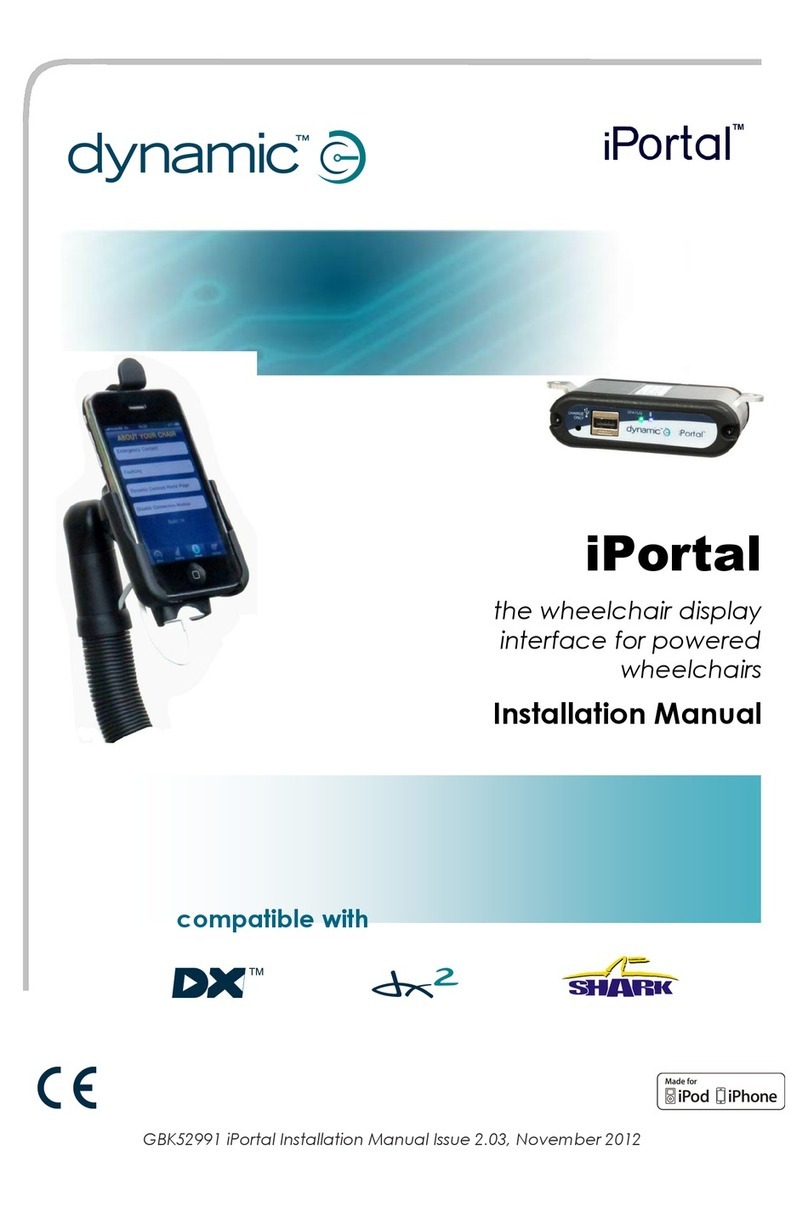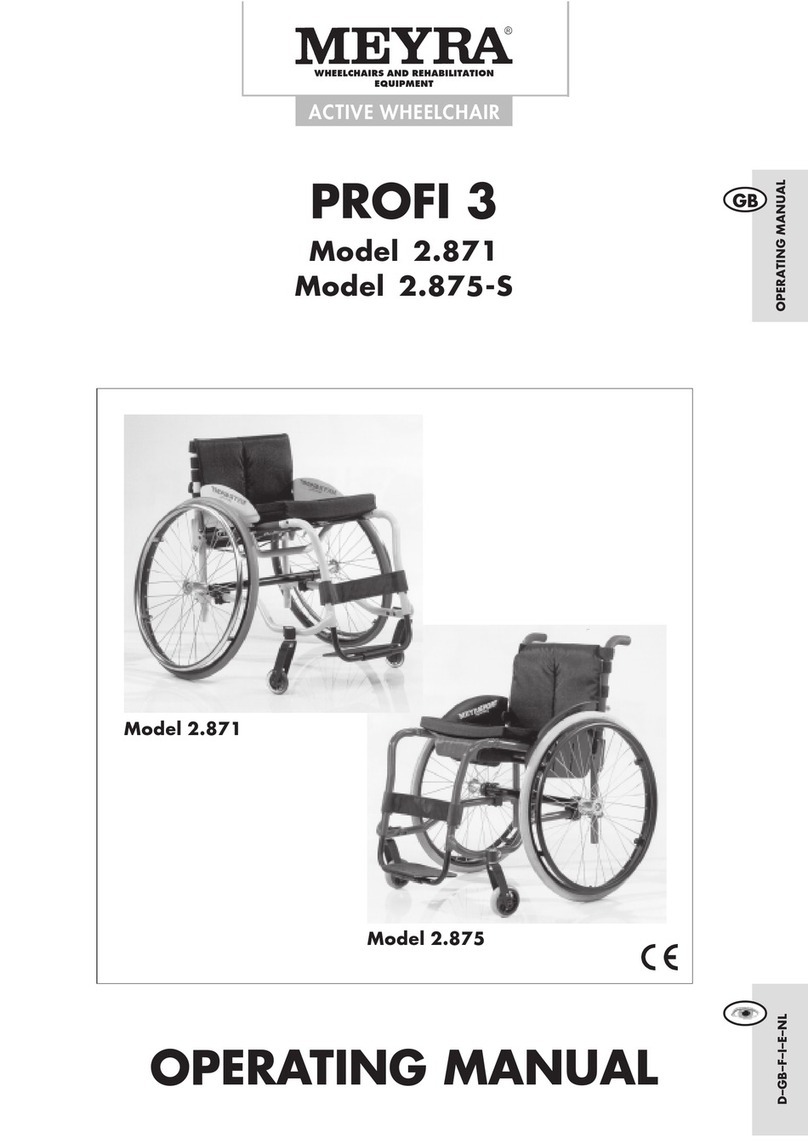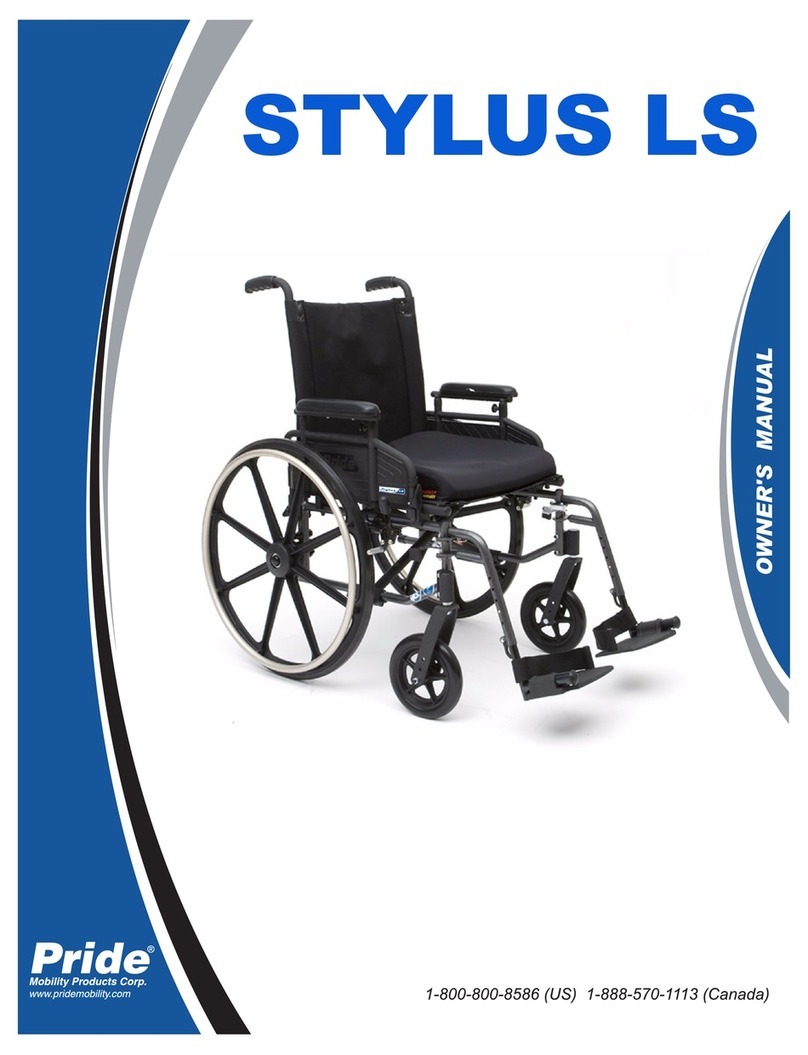MyWam Grizzly User manual

Grizzly
–
a modern rehab buggy with
perfect driving properties
Operation and
Maintenance Manual
Issue 5

CAUTION! A user with a vision, reading or cognitive incapacity, they are as ed to report to the
Manufacturer in order to obtain information for the user in the appropriate format. Contact data
of the Manufacturer :
● postal address: MyWam sp.j., ul. Szczecińs a 10, 41-516 Chorzów, Poland
● contact phone number: +48 32 733 11 31
● e-mail address: mywam@mywam.pl
CAUTION! Before using the rehab buggy, each User is obliged to read the content of this manual
and comply with it.
CAUTION! This manual is an integral part of the product and must always be included with the sold product.
Version of the Operation and Maintenance Manual: EN
Issue: fifth, dated: 2018-10-05
MyWam sp.j. reserves the right to introduce technical and commercial changes in the contents of the
Operation and Maintenance Manual without prior notice. Each change will be determined by the date of
the last update of the instruction.

v e r . 2 0 1 8 - 0 7 - 0 2
G r i z z l y
3
TABLE OF CONTENTS
INTRODUCTION
. Purpose of this Manual ........................................................................................................................ 6
2. Purpose of the Grizzly rehab buggy ...................................................................................................... 6
SAFETY
3. Important safety information and instructions......................................................................................... 7
general .................................................................................................................................................................... 7
in particular regarding construction and regulation.................................................................................................. 8
in particular regarding assembly and disassembly.................................................................................................... 7
in particular regarding preparation for use............................................................................................................... 9
in particular regarding handling of the rehab buggy................................................................................................ 10
in particular regarding getting in and out of the rehab buggy and the correct position in the rehab buggy........... 10
in particular regarding driving the rehab buggy....................................................................................................... 10
in particular regarding moving around sloping surfaces........................................................................................... 11
in particular regarding dealing with thresholds or curbs........................................................................................... 11
in particular, regarding the transport of the rehab buggy in a car and other vehicles............................................. 11
in particular regarding maintenance and service...................................................................................................... 1
4. Identification plate ................................................................................................................................ 2
5. Warning signs ........................................................................................................................................ 2
6. Designation of symbols .......................................................................................................................... 3
PRODUCT
7. General construction ............................................................................................................................. 3
7.1. Rehab buggy frame ....................................................................................................................................... 13
7.2. Therapeutic seat with bac rest......................................................................................................................... 14
7.3. Accessories ..................................................................................................................................................... 14
8. Detailed description of construction and regulation.................................................................................. 5
REHAB BUGGY FRAME
8.1. Mechanism of frame assembly.......................................................................................................................... 15
8.2. Disassembly of the rehab buggy frame.............................................................................................................. 15
8.3. Assembly of the rehab buggy frame ............................................................................................................... 16
8.4. Transport loc .................................................................................................................................................. 16
8.5. Installation and removal of the transport loc ................................................................................................... 16
8.6. Front swiveling wheels, full................................................................................................................................ 16
8.7. Front wheel quic -fit mechanism....................................................................................................................... 17
8.8. Front wheel assembly......................................................................................................................................... 17
8.9. Front wheel disassembly..................................................................................................................................... 17
8.10. Front wheel drive loc .......................................................................................................................................17
8.11. Attaching and removing the front wheel drive loc ......................................................................................... 18
8.12. Rear wheels, full................................................................................................................................................ 18

G r i z z l y
v e r . 2 0 1 8 - 0 7 - 0 2
4
8.13. Quic -assembly mechanism for rear axle wheels.......................................................................................... 18
8.14. Assembly and disassembly of rear axle wheels............................................................................................ 18
8.15. Quic -assembly rear wheel mechanism...................................................................................................... 19
8.16. Assembly and disassembly of the rear wheels on the frame....................................................................... 19
8.17. Rear wheel suspension system..................................................................................................................... 19
8.18. Ergonomic handle to push the rehab buggy ............................................................................................... 20
8.19. Angle adjustment mechanism for the pushing handle.................................................................................. 20
8.20. Angular adjustment of the handle for pushing the rehab buggy..................................................................... 20
8.21. Central bra e.................................................................................................................................................... 20
8.22. Switching the central bra e on and off............................................................................................................ 21
8.23. Tilting foot........................................................................................................................................................ 21
8.24. Frame clips for seat mounting......................................................................................................................... 21
THERAPEUTIC SEAT WITH BACKREST
8.25. Seat attachment mechanism for rehab buggy frame...................................................................................... 22
8.26. Seat assembly ................................................................................................................................................ 22
8.27. Seat disassembly ........................................................................................................................................... 24
8.28. Adjustable therapeutic seat............................................................................................................................. 25
8.29. Seat depth adjustment..................................................................................................................................... 25
8.30. Seat width adjustment.................................................................................................................................... 26
8.31. Mechanism of angle adjustment of the seat, so called cradle........................................................................ 27
8.32. Angular adjustment of the seat...................................................................................................................... 28
8.33. Adjustable bac rest.......................................................................................................................................... 28
8.34. Adjustable bac rest height............................................................................................................................... 28
8.35. Angle adjustment mechanism for the bac rest............................................................................................... 29
8.36. Angular adjustment of the bac rest................................................................................................................ 29
8.37. Five-point harness............................................................................................................................................ 30
8.38. Adjustment of five-point harness.................................................................................................................... 31
8.39. Adjustable footrest........................................................................................................................................... 31
8.40. Adjustable footrest plate height.................................................................................................................... 31
8.41. Angular adjustment of footplate................................................................................................................... 32
8.42. Angular adjustment mechanism for the whole footrest.................................................................................. 32
8.43. Angular adjustment of the entire footrest....................................................................................................... 32
ACCESSORIES
8.44. Adjustable headrest supports in three planes................................................................................................... 33
8.45. Thoracic and lumbar supports with adjustment in three planes....................................................................... 33
8.46. Hip supports adjustable in three planes............................................................................................................ 34
8.47. Side elements of the bac rest........................................................................................................................... 35
8.48. Abduction & Stabilization harness ................................................................................................................... 36
8.49. Protective barrier ............................................................................................................................................. 37
8.50. Adjustable canopy with window........................................................................................................................ 37
8.51. Therapeutic table............................................................................................................................................... 38

v e r . 2 0 1 8 - 0 7 - 0 2
G r i z z l y
5
8.52. Travel bag.......................................................................................................................................................... 38
8.53. Shopping bas et................................................................................................................................................ 39
8.54. Wedge ............................................................................................................................................................ 39
8.55. Rain cover ....................................................................................................................................................... 39
8.56. Winter gloves.................................................................................................................................................... 39
8.57. Sleeping bag for legs......................................................................................................................................... 40
8.58. Mosquito net .................................................................................................................................................. 40
8.59. Umbrella ......................................................................................................................................................... 40
8.60. Exclusive decorative set - Grizzly Bear ............................................................................................................ 41
9. Technical Specification............................................................................................................................ 4
USE
0. Delivery and tools................................................................................................................................... 43
. Assembly and disassembly...................................................................................................................... 44
2. Preparation for use ............................................................................................................................... 44
3. Transport of rehab buggy ...................................................................................................................... 45
4. Getting in and out of the rehab buggy..................................................................................................... 46
5. Correct position in the rehab buggy......................................................................................................... 46
6. Driving the rehab buggy.......................................................................................................................... 46
7. Moving on sloping surfaces..................................................................................................................... 46
8. Overcoming thresholds or curbs.............................................................................................................. 47
9. Transport by car and other vehicles........................................................................................................ 47
20. Using the buggy as a seat in a motor vehicle.......................................................................................... 47
MAINTENANCE
2 . Cleaning and care..................................................................................................................................... 53
22. Corrosion protection................................................................................................................................ 54
23. Preparation of the rehab buggy for long-term storage............................................................................. 54
24. Repeated use........................................................................................................................................... 54
25. Maintenance and periodic inspections.................................................................................................... 55
26. Disposal ................................................................................................................................................ 56
LEGAL DOCUMENTATION
27. Compliance with the requirements for medical devices.......................................................................... 56
28. Manufacturer ....................................................................................................................................... 57
29. Notes...................................................................................................................................................... 57
30. List of authorized service points............................................................................................................. 58
3 . Warranty Card........................................................................................................................................ 59
32. Terms of warranty.................................................................................................................................. 59

G r i z z l y
v e r . 2 0 1 8 - 0 7 - 0 2
6
. Purpose of this Manual
1.1. The operation and maintenance instructions contain the essential information necessary for the correct use of the
Grizzly rehab buggy, including safety instructions for use, description of its construction, operation and adjustment,
rehab buggy preparation, maintenance and cleaning of the rehab buggy and warranty conditions.
1.2. It is designed for people who ta e care of children with disabilities (assistants of children - parents, carers) that
will be transported in a rehab buggy. It is also suitable for doctors and rehabilitators operating the rehab buggy.
1.3. This manual should be ept in an accessible place.
1.4. CAUTION! Keep this manual for future reference!
2. Purpose of the Grizzly rehab buggy
2.1. The Special Grizzly Rehab buggy for Children is designed to carry a child with neurological, orthopedic or other
medical conditions that ma e it difficult or impossible to move independently.
2.2. The Grizzly rehab buggy is a medical device designed to carry a child with paralysis or quadriplegia, tetraplegia,
unilateral or crossed diplegia.
2.3. The Grizzly rehab buggy is designed to carry one child.
2.4. The Grizzly rehab buggy can be easily and safely adjusted to suit your child's individual needs.
2.5. The Grizzly rehab buggy is designed to carry a child whose weight does not exceed 45 g, with a height of 80cm to
140cm. Statistically these are children between the ages of 2 and 12.
2.6. Individual features such as physical and psychological characteristics, dimensions and body weight, housing
conditions, surroundings and, most importantly, the specific sic ness of the child are the most important when
selecting a rehab buggy.
2.7. Among illnesses of a particular child, conditions such as the following may be mentioned: cerebral palsy,
myelomeningocele, condition after spinal injury, condition after craniocerebral trauma, posttraumatic stro e,
condition after stro e, paralysis of various origin and other disfunctions damaging the human musculos eletal system
and disabling independent movement of the child.
2.8. Use the rehab buggy as instructed by a specialist.
2.9. The Grizzly rehab buggy is intended for indoor use (e.g., apartment, rehabilitation center) and outdoors (e.g. par ,
pavement), on hard and level surfaces where all four wheels touch the ground and their contact with the ground is
sufficient to properly drive the rehab buggy.
2.10. The Grizzly rehab buggy is designed to be controlled and driven only by an assistant (parent, guardian).
2.11. The Grizzly rehab buggy user is both the child which will be transported in it and the child's assistant (their
parent, carer, physician, rehabilitator) who will transport the child in a rehab buggy and ta e care of it.
2.12. The Grizzly rehab buggy, with proper care and maintenance, retains its quality for a period of 3 years and this is
the expected life span.
2.13. The ris s associated with using the rehab buggy are described in detail in the chapter: "Important safety
information and instructions”.

v e r . 2 0 1 8 - 0 7 - 0 2
G r i z z l y
7
3. Important safety information and instructions
General
3. . WARNING! Ris of accident - Before using the rehab buggy, the user is obliged to read and comply
with the entire contents of this manual.
3.2. WARNING! Ris of accident - Before starting and during use of the rehab buggy, observe the safety
information and instructions in this manual and follow the other recommendations in this manual.
3.3. . WARNING! Failure to comply with the instructions, and in particular those relating to moving parts
of the rehab buggy, may be hazardous to the user. 3.3.2. Always read the operation and maintenance
instructions before use.
3.4. WARNING! Never leave a child unattended in a rehab buggy because there is a ris of injury and an
accident!
3.5. WARNING! This product contains small parts that may be hazardous if swallowed by a child!
3.6. WARNING! Ris of injury - Always use all available safety systems for your child. These include: five-
point harness, headrest supports, thoracolumbar supports, hip supports, side elements of the bac rest,
restraint-stabilization belts, wedge, safety barrier or a therapeutic table in its place, footrest and harness
for placing the feet on the footrest.
3.7. WARNING! There is a ris of burns when using the rehab buggy- caution should be exercised when
transporting the child in a rehab buggy at high and low temperatures and in contact with the s in, e.g. in
the sun, in the cold, in the sauna, as the surface temperature of the rehab buggy may rise when the rehab buggy is
exposed to sunlight or the surface temperature of the rehab buggy may fall when the rehab buggy is exposed to frost.
3.8. WARNING! When using the rehab buggy or operating the rehab buggy or folding it, it may endanger
the health of the user and the immediate surroundings due to the dimensions of fixed and movable gaps
and openings. These actions should be performed with particular caution.
3.9. . WARNING! During use and operation of the rehab buggy and during the assembly and adjustment
of the mechanisms, there may be danger of entanglement and compression of the body part of the user
or companion in the openings and gaps between the elements. 3.9.2. These operations should be performed with
particular caution. 3.9.3. After completing these steps, the positions of the individual components of the rehab buggy
must be stabilized by precise tightening of the nuts, nobs and screws. In each case, the child must be ta en out of the
rehab buggy beforehand!
3.10. CAUTION! Never exceed the maximum load.
3.11. CAUTION! For the Grizzly rehab buggy, the maximum total weight is 45 g.
3.12. CAUTION! The maximum load of the travel bag is 2 g.
3.13. CAUTION! The maximum load for the shopping bas et is 3 g.
3.14. CAUTION! The maximum load of the therapeutic table is 3 g.
3.15. CAUTION! The rear poc et in the adjustable booth with a window is used only for placing a rain cover or
mosquito net in it.
3.16. CAUTION! Depending on the performed Grizzly rehab buggy adjustment - this concerns adjustment of the
handle for pushing the rehab buggy, adjustment of the bac rest height, angular adjustment of the bac rest,
adjustment of the seat depth, angular adjustment of the seat, adjustment of the footrest angle and footrest setting -
the rehab buggy can exceed the recommended maximum dimensions.

G r i z z l y
v e r . 2 0 1 8 - 0 7 - 0 2
8
3.17. CAUTION! In the event of a medical incident involving the presence of a Grizzly rehab buggy, you must
immediately notify the Manufacturer in writing, either by registered letter or by e-mail with ac nowledgment of
receipt, using the following addresses:
3.17.1. Postal address: MyWam sp.j., ul. Szczecińs a 10, 41-516 Chorzów, Poland
3.17.2. E-mail address: mywam@mywam.pl
3.18. The therapeutic seat is not suitable for children under 6 months.
3.19. It is forbidden to use the rehab buggy as a ladder or a base for climbing it to reach higher.
3.20. It is forbidden to use the rehab buggy in a way that the rehab buggy is not designed for.
in particular regarding the construction and regulation
3.2 . . WARNING! Any regulation of the rehab buggy and its components, any settings, changes,
attachments and other adjustments to the rehab buggy must be carried out WITHOUT THE CHILD placed
in the rehab buggy. 3.21.2. Failure to do so may cause serious harm to the child or to others!
3.22. WARNING! Adjustments performed in the rehab buggy, made in an incorrect manner or not in
accordance with the instructions in this manual are dangerous for the child and others!
3.23. . WARNING! Due to the great adjustability of the rehab buggy, when adjusting the angle of the seat
and adjusting the angle of the bac rest, it is possible to set a position where the head of the child is below
the ilial line. 3.23.2. It is forbidden to use such a position, as this could lead to the ris of relishing or cho ing.
3.24. WARNING! The Grizzly Bear decorative set (accessories) is gentle and caution must be underta en
to ensure that the child does not damage its hair and does not put it in the mouth as this can cause the
baby to relish!
3.25. WARNING! Any alteration in the tilt of the seat causes a change in the overall center of gravity, which affects the
stability of the rehab buggy.
3.26. WARNING! Any alteration in the bac rest tilt changes the overall center of gravity, which affects the stability of
the rehab buggy.
3.27. WARNING! Any change in the bac rest tilt requires re-adjustment of the length of the five-point harness!
3.28. WARNING! The central bra e is not intended to slow the rehab buggy in motion and must only be used to
immobilize the rehab buggy.
3.29. The front swiveling wheels, if the loc for the direction of movement is disabled, may vibrate at uneven surfaces
and lead to a sudden stop of the rehab buggy and its tipping over. Therefore, in the case of uneven surfaces, it is
advisable to loc the direction of movement of the front wheels and push the rehab buggy at a reduced speed.
3.30. All regulations and adjustments should be made under the supervision and care of a physician and
physiotherapist.
in particular regarding assembly and disassembly
3.3 . CAUTION! To avoid injury, ma e sure the child is at a far and safe distance when the rehab buggy is
assembled and disassembled.
3.32. CAUTION! The rehab buggy must be fully assembled before use. Should you encounter any
problems at this stage, please contact the Seller and the Manufacturer immediately.
3.33. CAUTION! During assembly of the rehab buggy and when mounting the seat to the rehab buggy
frame, pay particular attention if the loc ing mechanism of the seat attachment to the rehab buggy frame
is properly closed because otherwise there is a serious ris of injury to the user!

v e r . 2 0 1 8 - 0 7 - 0 2
G r i z z l y
9
3.34. . CAUTION! When assembling the rehab buggy and mounting the seat to the rehab buggy frame,
care must be ta en to ensure that the seat is mounted on the proper frame clips. 3.34.2. Attaching the
seat to other components of the rehab buggy frame is incorrect and poses a ris of an accident!
3.35. . CAUTION! It is forbidden to place additional weight on the rehab buggy, in particular to place
additional weight on the bac of the bac rest, for example a bac pac or bag. 3.35.2. This can cause the
Grizzly rehab buggy to roll over and damage the user!
3.36. CAUTION! Ensure safe distance from the moving parts of the rehab buggy during assembly and
disassembly of the rehab buggy, as there is a ris of crushing your fingers, hands or other body parts.
3.37. CAUTION! During assembly and disassembly of the wheels to the rehab buggy frame, be sure to
chec that they are correctly installed as there is a ris of injury.
3.38. WARNING! Do not dismantle the rehab buggy frame if the transport loc is mounted, as this may cause damage
to the rehab buggy.
3.39. WARNING! When mounting the therapeutic seat with the bac rest to the rehab buggy frame in a different
direction from that previously installed, it is important to remember that this changes the center of gravity and affects
the stability of the rehab buggy.
3.40. All additional components attached to the rehab buggy affect its stability.
3.41. The Grizzly rehab buggy bac rest should only be fitted to the Grizzly rehab buggy frame and not to any other
rehab buggy or equipment.
in particular regarding preparation for use
3.42. CAUTION! Before using the rehab buggy, ma e sure that the rehab buggy is properly assembled and
that all mechanisms, clips and fasteners are properly assembled, closed and ready to use. In particular, this applies to:
the frame folding mechanism, the mechanism of seat attachment to the rehab buggy frame and mounting of all four
wheels.
3.43. CAUTION! Before you start to drive the Grizzly rehab buggy, ma e sure your child is secured and has
properly regulated and assembled five-point harness because there is a ris of injury.
3.44. . CAUTION! The frame folding mechanism is a very important element in the
construction of the rehab buggy, therefore it is important to each time pay particular attention to the
absence of crac s and damage to the frame folding mechanism and its proper operation before use. 3.44.2. In case of
any suspicion, the rehab buggy must not be used because it is dangerous for the child, his assistant and others! 3.44.3.
In this situation, it is advisable to contact the Deller and the Manufacturer for advice.
3.45. CAUTION! Correct use of the folding mechanism is important for the safety of the child and others.
3.46. WARNING! Prior to use, the rehab buggy's upholstery must always be dry.
3.47.1. WARNING! Prior to each use, always follow the steps listed below, and do not use the rehab buggy in the event
of a malfunction. In this situation, it is advisable to contact the Seller and the Manufacturer for advice. 3.47.2. Prior to
each use of the rehab buggy, perform the following actions:
3.47.1. Inspect the rehab buggy for visible damage or other defects that could harm the child while operating the
rehab buggy.
3. 47.2. Chec that the rehab buggy frame has been properly folded and that the folding mechanism of the frame has
been properly closed (loc ed).
3. 47.3. Chec that the seat has been correctly fitted to the rehab buggy frame and that the seat attachment
mechanism to the rehab buggy frame has been properly closed (loc ed).

G r i z z l y
v e r . 2 0 1 8 - 0 7 - 0 2
10
3. 47.4. Chec that all four wheels are properly assembled.
3. 47.5. Chec the good condition tread's tires on all four wheels
3. 47.6. Chec the functioning of the central bra e.
3. 47.7. Correctly perform all adjustments and adjust the rehab buggy to the needs of the child, including the
appropriate depth of the therapeutic seat and bac rest height, appropriate tilting of the therapeutic seat and tilt of
the bac rest, adjust the appropriate tilt of the footrest, regulate the appropriate length of the five-point harness.
3. 47.8. Chec that all regulation elements are properly placed and secured.
3. 47.9. Ma e sure the rehab buggy upholstery is dry.
3. 47.10. Secure the child with five-point harness to protect the child from falling out and slipping out of the rehab
buggy.
3. 47.11.a. Secure the child with all available stabilizing elements, such as: five-point harness, headrest support,
thoracolumbar support, hip support, restraint-stabilization harness, wedge, footrest, harness of footrest, safety
barrier or therapeutic table. 3. 47.11.b. This is to protect your child from falling off and slipping out of the rehab buggy
and to protect the child's feet from falling from the footrest.
3.48.1. WARNING! Do not use the rehab buggy if the technical condition of the rehab buggy or an individual rehab
buggy element is incorrect or if you have any doubts that the rehab buggy is damaged or there is only a suspicion that
the rehab buggy has been damaged or that the rehab buggy is not wor ing properly. 3.48.2. In this situation, it is
advisable to contact the Seller and the Manufacturer for advice.
in particular regarding handling of the rehab buggy
3.49. WARNING! It is forbidden to carry or lift the rehab buggy with a child inside.
3.50. WARNING! It is forbidden to carry the rehab buggy that is not dismantled into separate parts: the rehab buggy
frame separately, disassembled therapeutic seat with bac rest separately, separate dismantled equipment of the
additional rehab buggy.
3.51. WARNING! Do not lift the rehab buggy holding the footrest or safety barrier, therapeutic table or any other
accessories.
in particular regarding getting in and out of the rehab buggy and the correct position in the rehab buggy
3.52. CAUTION! Do not stand on the plate of the footrest as there is a ris of overturning the rehab buggy,
injury to the user and the ris of damage to the product.
3.53. CAUTION! Please note that when helping the child get in and out of the rehab buggy, the child and
no other person should not stand on the footrest, as it may damage the footrest and injure the child!
3.54. WARNING! When the child gets in our out of the rehab buggy, the central bra e must be engaged.
3.55. WARNING! When the child gets in our out of the rehab buggy, ma e sure the center bra e of the rehab buggy is
engaged.
in particular regarding driving the rehab buggy
3.56. CAUTION! Do not let go of the rehab buggy or push it away as it can cause an accident.
3.57. CAUTION! This product is not suitable for running or s ating.
3.58. CAUTION! Use of the product is prohibited for sports purposes.

v e r . 2 0 1 8 - 0 7 - 0 2
G r i z z l y
11
3.59. WARNING! Please note that when using the rehab buggy, the child's limbs should not get between the spo es of
the wheel and the adjustable rehab buggy parts.
3.60. WARNING! When passing through a door or a similar narrowing that limits the direction of movement of the
rehab buggy, ma e sure that there is adequate space on both sides of the rehab buggy which prevents the hands or
other parts of the body from being trapped, it also prevents any damage of the rehab buggy.
3.61. When moving on the rehab buggy on public roads, follow the highway code.
in particular regarding moving around sloping surfaces
3.62. CAUTION! It is forbidden to leave the child in a rehab buggy without supervision of an adult and
responsible assistant (parent, guardian), this particularly regards leaving the child in a rehab buggy on
sloping grounds, as this may cause an accident and injury to the user!
3.63. CAUTION! Do not exceed the maximum vehicle load when using driveways, as this may result in
injury to users and the persons in the environment.
3.64. CAUTION! When using ramps, ma e sure that the ramp is proper, and that the wheels of the rehab
buggy are high enough to overcome the ramp, that the frame of the rehab buggy will not come into
contact with the ramp and that assistance should be provided to the other person as there is a ris of overturning the
rehab buggy, causing damage of the product and injury of the user.
3.65. WARNING! Always eep in mind that the center of gravity of the rehab buggy changes as you drive through
bumps or slopes. In this case, caution should be underta en and the rehab buggy should be secured.
in particular regarding dealing with thresholds or curbs
3.66. CAUTION! It is forbidden to drive up or down the stairs with the rehab buggy, both with the child
and the rehab buggy itself, as this can result in an accident and injury to the user!
in particular, regarding the transport of the rehab buggy in a car and other vehicles
3.67. CAUTION! It is forbidden to carry a child in a rehab buggy and at the same time in all other means of
transportation, e.g. in a car, on a train, on a tram, on a bus, on an airplane, on a ship or other, as it may
cause injury.
3.68. CAUTION! It is forbidden to use the rehab buggy seat as a car seat as it can cause injury
3.69. CAUTION! Ris of an accident and injury to the user and surrounding environment - when carrying
the rehab buggy in other means of transport, such as in a car, on a bus, or on a train, ma e sure that the
rehab buggy is properly secured to prevent personal injury during collisions or violent bra ing.
3.70. WARNING! When transporting the rehab buggy in other means of transport, e.g. in a car, on a bus, on a train,
the rehab buggy must be transported without a child and the rehab buggy must be well protected against possible
damage.
3.71. WARNING! The manufacturer is not liable for any damages resulting from improper product protection during
transport.
3.72. WARNING! When transporting the rehab buggy in other means of transport, e.g. in a car, on a bus, on a train, do
not use one safety belt to protect both the passenger and the rehab buggy.
3.73. Use a transport loc when transporting the rehab buggy and during its storage.

G r i z z l y
v e r . 2 0 1 8 - 0 7 - 0 2
12
in particular regarding maintenance and service
3.74. WARNING! The Manufacturer is responsible for defects or technical damages of the rehab buggy that have
occurred solely during correct operation of the rehab buggy. The responsibility for the proper functioning of the rehab
buggy rests with the Manufacturer only in the case of strict compliance with all the Manufacturer's recommendations.
3.75. WARNING! The manufacturer is responsible for the correct operation of the rehab buggy only in the case of use
of original parts and original accessories.
3.76. Only original spare parts that are supplied or recommended by the Manufacturer may be used in the rehab
buggy.
3.77.1. Repairs of the rehab buggy carried out by persons other than authorized Service (see chapter 30. List of
Authorized Service Points) or Manufacturer will cause loss of warranty. 3.77.2. The Manufacturer is not liable for any
personal injury or damage that may result from repairs performed by persons other than authorized Maintenance
personnel (see section 30. List of authorized service points) or Manufacturer.
3.78. The rehab buggy should be cleaned regularly and ta en care of. Do not use abrasive cleaners for cleaning.
3.79. The manufacturer is responsible for the correct functioning of the rehab buggy only if purchased in a specialized
medical shop.
3.80. The manufacturer is not responsible for the appropriate selection of accessories for the user.
4. Identification plate Fig.4.1.
4.1. The identification place contains the basic information
about the product: the name, model, serial number
(identification), maximal load, date of manufacturing,
confirmation of product conformity for medical devices, warning
of handling according to the operating and maintenance
instructions and manufacturer's data (see Fig. 4.1).
4.2. The identification plate is located on the transverse beam at
the rear of the rehab buggy frame, to its left, glued from the top.
5. Warning signs Fig.5.1.
5.1. The warning plate contains important warnings for the
user (see Fig. 5.1).
5.2. The warning plate is located on the transverse beam at the
rear of the rehab buggy frame, to its right, glued from the top.

v e r . 2 0 1 8 - 0 7 - 0 2
G r i z z l y
13
6. Designation of symbols
6.1. Serial number of the product
6.2. Allowable total user weight
6.3. Production date
6.4. The conformity mar according to the Medical Device Directive 93/42 EEC, Annex VII
6.5. Warning about proceeding according to the Product Operation and Maintenance Manual
6.6. Name of manufacturer
6.7.1. The "WARNING" mar used in this manual is used to enhance the reader's attention to the
content of this mar . 6.7.2. Failure to comply with the content mar ed with this symbol may
jeopardize the health and safety of the user and assisting persons and may result in damage to
the product.
7. General construction
The Special Children's Grizzly Rehab buggy consists of two main parts: a rehab buggy frame and a therapeutic seat
with a bac rest.
The Grizzly rehab buggy also features a wide range of extra equipment which can be selected according to individual
needs of the users.
7. . Steel rehab buggy frame enriched with aluminum elements.
The elements of the rehab buggy include:
7.1.1. Mechanism of frame assembly (see Fig.7.1. and no. 14; and on page 15)
7.1.2. Transport loc (see Fig.7.1. and no. -; and on page 16)
7.1.3. Front swivel wheels, full (see Fig.7.1. and no. 7; and on page 16)
7.1.4. Front wheel quic -fit mechanism (see Fig.7.1. and no. 5; and on page 16)
7.1.5. Front wheel drive loc (see Fig.7.1. and no. 4; and on page 17)
7.1.6. Rear wheels, full (see Fig.7.1. and no. 9; and on page 18)
7.1.7. Quic -fit mechanism for rear axle wheels (see Fig.7.1. and no. 8; and on page 18)
7.1.8. Quic -fit rear wheel mechanism (see Fig.7.1. and no. 13; and on page 19)
7.1.9. Rear wheel suspension system (see Fig.7.1. and no. 12; and on page 19)
7.1.10. Ergonomic handle to push the rehab buggy (see Fig.7.1. and no. 1; and on page 19)

G r i z z l y
v e r . 2 0 1 8 - 0 7 - 0 2
14
7.1.11. Angle adjustment mechanism of the pushing handle (see Fig.7.1. and no. 2; and on page 20)
7.1.12. Central bra e (see Fig.7.1. and no. 11; and on page 20)
7.1.13. Tilting foot (see Fig.7.1. and no. 10; and on page 20)
7.1.14. Frame hoo s for seat mounting (see Fig.7.1. and no. 3; and on page 21)
7.1.15. Angular adjustment mechanism of the seat, so-called cradle (see Fig.7.1. and no. 6; and on page 26)
Fig.7.1. Fig.7. .
7.2. Therapeutic seat with backrest
Its elements include:
7.2.1. Adjustable therapeutic seat (see Fig.7.2. and no.3; and on page 24)
7.2.2. Seat attachment mechanism for rehab buggy frame (see Fig.7.2. and no.6; and on page 21)
7.2.2. Adjustable bac rest (see Fig.7.2. and no.1; and on page 27)
7.2.3. Angular adjustment mechanism for the bac rest (see Fig.7.2. and no.7; and on page 28)
7.2.4. Five-point harness (see Fig.7.2. and no.2; and on page 29)
7.2.5. Adjustable footrest (see Fig.7.2. and no.4; and on page 30)
7.2.6. Angular adjustment mechanism for the whole footrest (see Fig.7.2. and no.5; and on page 31)
7.3. Accessories (see Fig.7.3)
7.3.1. Head supports (and on page 31)
7.3.2. Thoracolumbar supports (and on page 32)
7.3.3. Hip supports (and on page 33)
7.3.4. Side elements of the bac rest (and on page 34)
7.3.5. restraint-stabilization harness (and on page 34)
7.3.6. Security frame (and on page 35)

v e r . 2 0 1 8 - 0 7 - 0 2
G r i z z l y
15
Fig.7.3
7.3.7. Adjustable roofing with a window (and on page 36)
7.3.8. Therapeutic table (and on page 37)
7.3.9. Travel bag (and on page 37)
7.3.10. Shopping bas et (and on page 37)
7.3.11. Wedge (and on page 38)
7.3.12. Rain cover (and on page 38)
7.3.13. Winter gloves (and on page 38)
7.3.14. Sleeping bag for legs (and on page 38)
7.3.15. Mosquito net (and on page 39)
7.3.16. Umbrella (and on page 39)
7.3.17. Exclusive decorative set - Grizzly Bear (and on page 39)
8. Detailed description of construction and regulation
8. . Mechanism of frame assembly Fig.8.1.
The frame folding mechanism is located inside the frame, and on the frame in three
places in its left part and in three places in its right side. Describing these places from the
top, from the rehab buggy pushing handle, they are:
a) frame folding loc - a handle for loc ing and unloc ing the frame folding option, which
has a red loc built in on the right part of the frame (see Fig. 8.1)
b) right and left frame swivel - element fixing the upper frame with the bottom frame
(see Fig.8.1.)
c) right and left twister- an element that allows the upper frame to be folded down to
reduce its dimensions (see Fig.8.1.)
8.2. Disassembly of the rehab buggy frame Fig.8. .
To unfold the rehab buggy frame: place the rehab buggy frame horizontally on
the ground so that the pushing handle is at the top, then remove the transport
loc (see 8.5 Mounting and removing the transport loc ) and pull up the rehab
buggy pushing handle (see Fig. 8.2.) until hearing a clear clic . The rehab buggy
frame will be properly disassembled only when the folding mechanism of the
frame is properly closed. This is evidenced by the clear "clic " sound coming from
the well-closed frame folding mechanism.

G r i z z l y
v e r . 2 0 1 8 - 0 7 - 0 2
16
8.3. Assembly of the rehab buggy frame Fig.8.3.
To fold the rehab buggy frame: Push the red folding frame loc ing button (see section 8.1
Frame folding mechanism) and simultaneously pull both frame folding handles upward
towards the push handle (see Fig. 8.3). Then fold the rehab buggy frame forward, in the
direction of the front wheel mounting, then attach the transport loc .
8.4. Transport lock Fig..8.4.
The rehab buggy is equipped with a transport loc which serves to secure the
folded (closed) frame of the rehab buggy prior to its automatic opening during
transport and storage.
The transport loc consists of two parts (see Fig.8.4): eyelet (female element)
and pin (male element).
8.5. Installation and removal of the transport lock Fig.8.5.
In order to secure the frame against its accidental opening, the frame must first
be folded (see 8.3. Assembly of the rehab buggy frame) and then place the loc
eyelet on the loc ing pin so that both of these elements close over each other.
To unloc the transport loc , before unfolding the frame, pull the loc eyelet out
of the loc ing pin, and then you can proceed to unfold the frame of the rehab
buggy.
8.6. Front swiveling wheels, full Fig. 8.6.
Wheels of German production guarantee the highest quality of rehab buggy
driving, pleasure from driving and an elegant appearance. The tires are tubeless,
filled with a special gel, which has suspension qualities very close to pneumatic
tires. The wheels are pre-assembled in the for s of the front wheels, which are
ended with front wheel steering axle from the top (see Fig.8.6).
Both front wheels can be set for driving straight ahead or unloc ed for turning,
which ma es handling of the rehab buggy much easier (see 8.10. Front wheel
drive loc ).

v e r . 2 0 1 8 - 0 7 - 0 2
G r i z z l y
17
8.7. Front wheel quick-fit mechanism Fig.8.7.
The mechanism is mounted on the front ends of the frame and ensures fast assembly and
dismounting of the front wheels. It is activated by pressing the quic disassembly button
down, towards the ground (see Fig. 8.7). The wheel is mounted from below through a
vertical hole.
8.8. Front wheel assembly Fig.8.8.
Place both front wheels. To do this, apply the wheel turning axle to the quic disassembly
opening until the clic (see Fig.8.8).
A clear "clic " sound is a sign of correct placement of the wheel, derived from the fast
wheel disassembly mechanism.
8.9. Front wheel disassembly Fig.8.9.
When disassembling the front wheel, press the button located at the top of the quic
disassembly mechanism of the front wheels. Then slide the steering wheel axle out of the
quic -disassembly mechanism of the front wheels (see Fig.8.9.). Repeat for the second
wheel.
8. 0. Front wheel drive lock Fig.8.10.
With the front wheel loc (see Fig. 8.10) and the possibility of assembling or
disassembling it, when pushing the rehab buggy, the bigger comfort of both the child and
the assistant is clearly noticeable.
It is advisable to remove the loc and allow the front wheels to be tilted while driving the
rehab buggy on a completely smooth surface such as in shopping centers, schools.
On the other hand, in the case of inferior surfaces, moving on inclined surfaces, when
crossing thresholds or curbs, it is recommended to mount a loc and loc ing the turning
of front wheels.

G r i z z l y
v e r . 2 0 1 8 - 0 7 - 0 2
18
8. . Attaching and removing the front wheel drive lock Fig.8.11.
To loc the turning of the front wheels, turn the nob of the directional loc to the left
(see Fig.8.11.).
To unloc the turning of the front wheels, turn the directional loc nob to the right.
8. 2. Rear wheels, full Fig.8.1 .
Wheels of German production (see Fig. 8.12) guarantee the highest quality of
rehab buggy driving, pleasure from driving and an elegant appearance. The tires
are tubeless, filled with a special gel, which has suspension characteristic very
close to pumped wheels.
With the ability to dismantle both the wheels and their axles, the rehab buggy is
smaller after folding, which facilitates its transport and storage.
8. 3. Quick-assembly mechanism for rear axle wheels Fig.8.13.
The mechanism is mounted inside the rear wheels and ensures quic assembly and
removal of the rear wheels. It is launched by pressing the quic -release clamp downward
towards the center of the wheel (see Fig. 8.13), then the rear wheel can be fitted to the
rear wheel axle or the rear wheel can be ta en off from the rear wheel axle.
8. 4. Assembly and disassemble of rear axle wheels Fig.8.14.
When attaching the rear wheel to the rear wheel axle, push the clamp on the center of
the wheel and mount the wheel to the top of its axle (see Fig. 8.14). Then stop pressing
on the clamp and continue inserting the wheel on its axle until it clic s. Correct mounting
of the wheel means a clear "clic " sound coming from the quic -release mechanism of the
rear wheel axle.
To disassemble the rear wheel from the rear wheel axle, press the buc le on the center of
the wheel and slide the wheel off its axle.

v e r . 2 0 1 8 - 0 7 - 0 2
G r i z z l y
19
8. 5. Quick-assembly rear wheel mechanism Fig.8.15.
The mechanism is mounted on the rear end of the frame, in contact with the
cross-beam and ensures quic assembly and removal of the rear wheels. It is
launched by pressing the quic -release button downward toward the ground
(see Fig. 8.15). The wheel in this mechanism is mounted from the side, from the
outside, through the horizontal opening.
8. 6. Assembly and disassembly of the rear wheels on the frame Fig.8.16.
8.16.1. Assembly of the rear wheels to the rehab buggy frame
Place both rear wheels together with their axles in the opening of the mechanism. Then
press the quic -release button to allow the axle to slide, then slide the wheel with the
axle into the hole until it clic s (see Fig.8.16.). The "clic " sound comes from the
appropriate mounting of the quic -wheel mechanism on the frame. To ma e sure that
the assembly is correct, chec that the wheel with the axle cannot slide out of the holes
of the mechanism bac outside.
During assembly of the rear wheels on the frame, ma e sure to hold the wheel at its inner
rim and to not push on the quic -assembly clamp of the rear wheel axle as it poses a
threat of automatic disassembly of the rear wheel from the rear wheel axle. 8.16.2.
Removing the rear wheels from the rehab buggy frame. When disassembling the rear
wheel from the rehab buggy frame, push the rear wheel quic -release button from the
rehab buggy frame down toward the ground. Then, holding the wheel behind its inner rim,
slide the wheel out along with its axle.
8. 7. Rear wheel suspension system Fig.8.17.
The rehab buggy is equipped with spring-loaded and rear wheel suspension,
located at the rear ends of the frame, in contact with the cross-beam (see Fig.
8.17). It should not be regulated. Suspension is automatic.

G r i z z l y
v e r . 2 0 1 8 - 0 7 - 0 2
20
8. 8. Ergonomic handle to push the rehab buggy Fig.8.18.
The handle (see Fig.8.18) is used to push the rehab buggy, providing a secure grip in a
variety of driving conditions. It has the possibility of adjusting the height of the handle for
the child's assistant pushing the rehab buggy.
8. 9. Angle adjustment mechanism for the pushing handle Fig.8.19.
These are two buttons on the outer side of the frame, located on the joints of
the handle to push the rehab buggy (see Fig. 8.19.).
8.20. Angular adjustment of the handle for pushing the rehab buggy Fig.8. 0.
To change the tilting angle of the rehab buggy handle, push both nobs of the tilt angle
adjustment mechanism of the pushing handle and change its tilt angle (see Fig.8.20.).
When the handle is in the correct position, stop pressing the buttons, which will
automatically loc the handle to the desired position.
8.2 . Central brake Fig.8. 1.
The central bra e pedal the pressing of which directly loc s the two rear wheels
of the rehab buggy, is located in the center of the cross-beam at the rear of the
rehab buggy frame.).
Other manuals for Grizzly
1
Table of contents
Popular Wheelchair manuals by other brands

Invacare
Invacare Pronto M41 Service manual
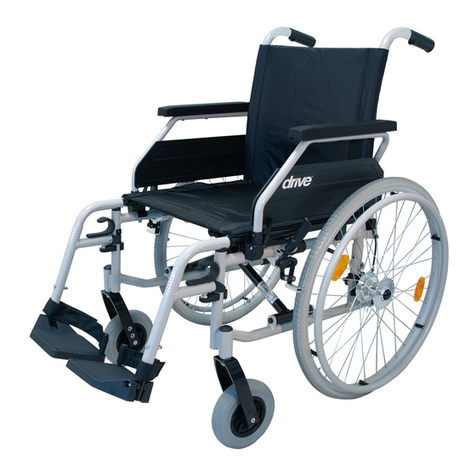
Drive DeVilbiss
Drive DeVilbiss Ecotec 2G operating instructions
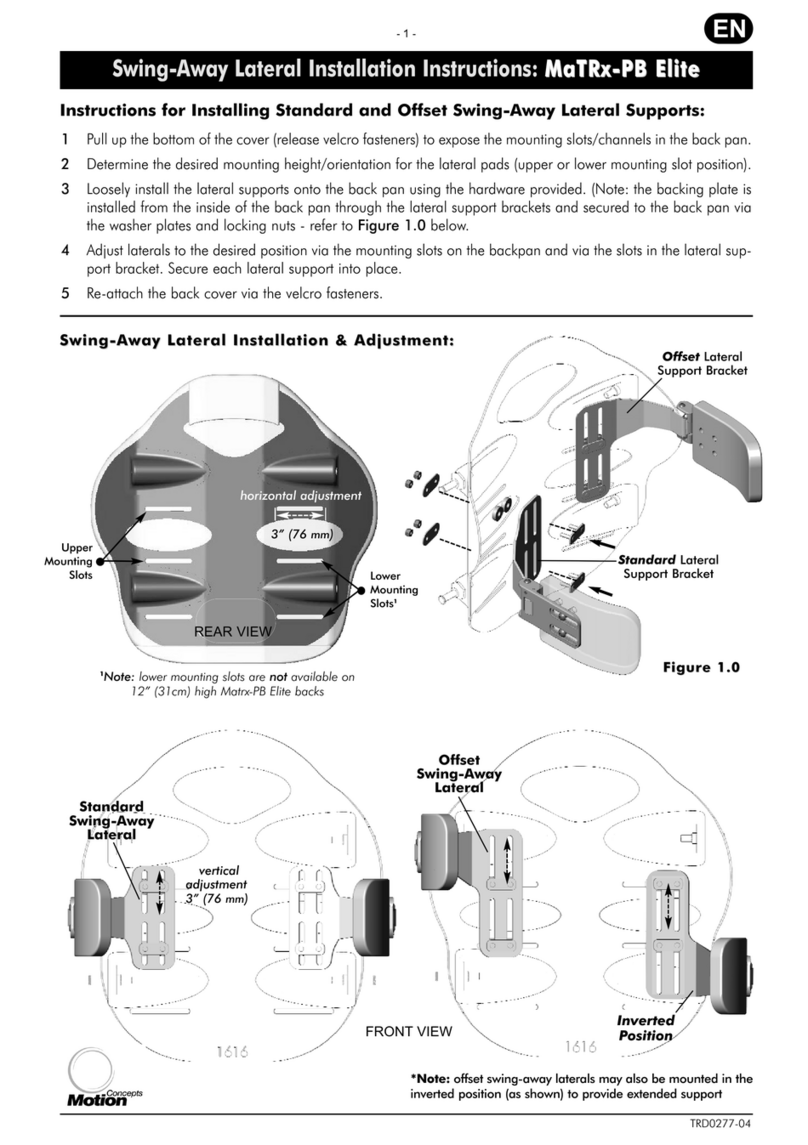
Invacare
Invacare Motion Concepts MaTRx Seating Series installation instructions

Meyra-Ortopedia
Meyra-Ortopedia 1.360 operating manual

Jay
Jay Care Back owner's manual
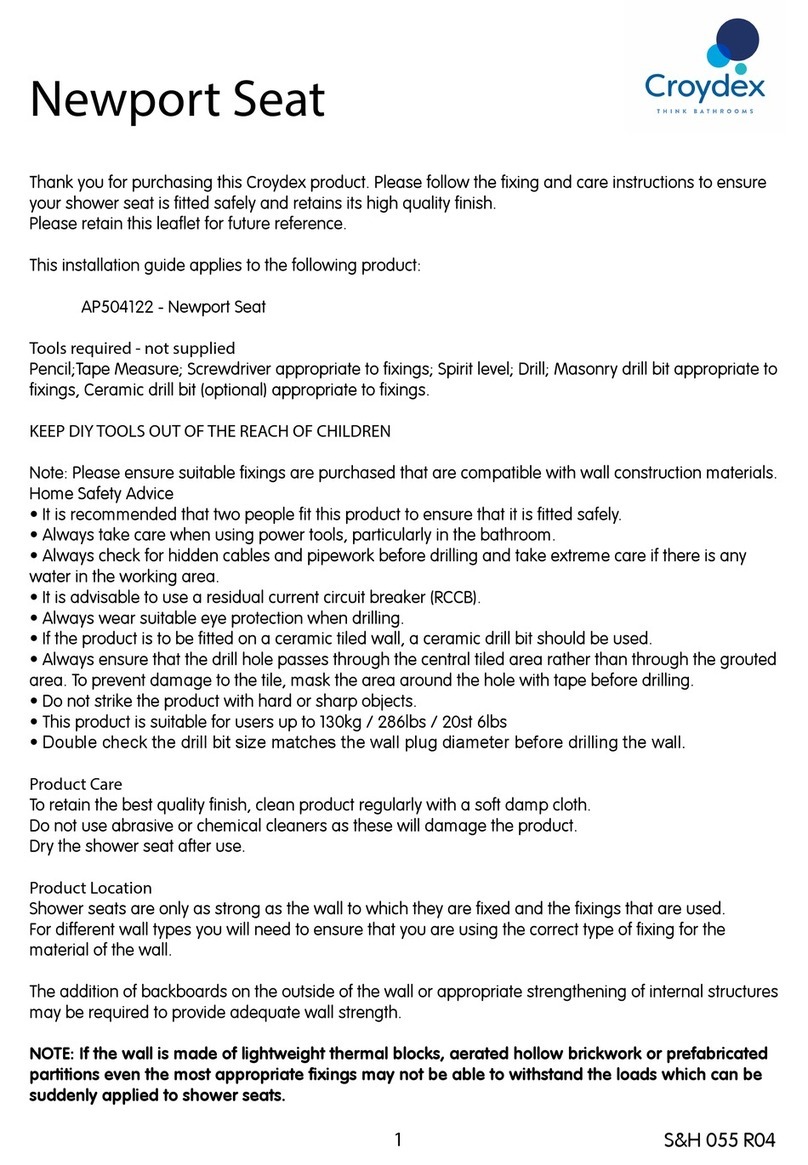
Croydex
Croydex Newport AP504122 manual
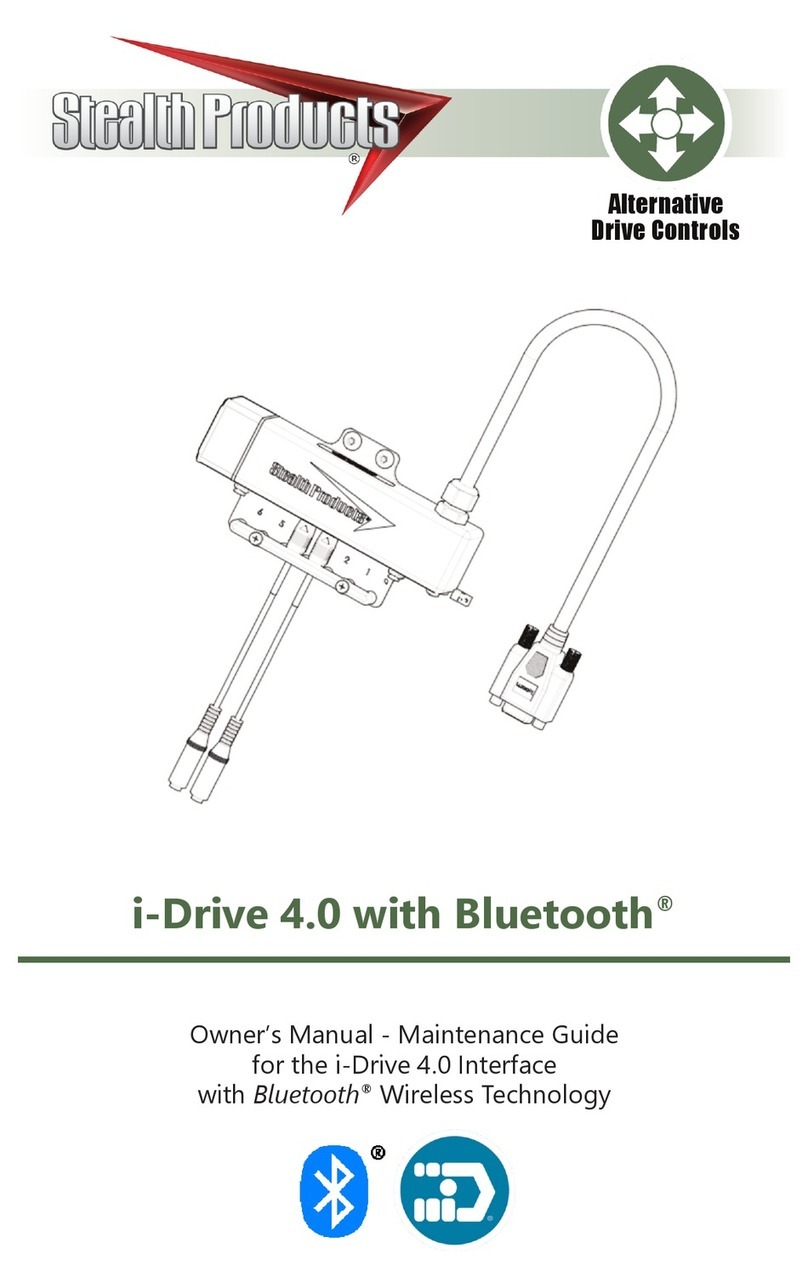
Stealth Products
Stealth Products i-Drive Owner's manual & maintenance guide

Motobility
Motobility Solax Genie Plus user manual
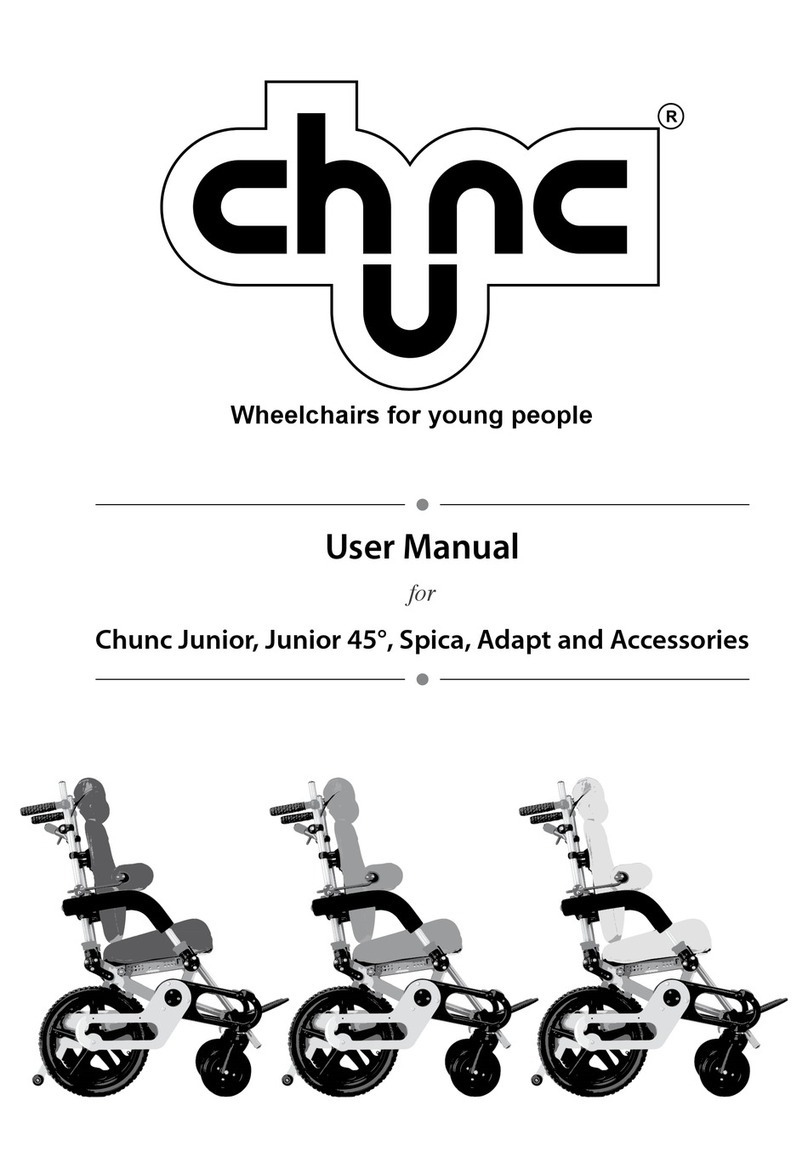
Chunc
Chunc junior user manual

Everest & Jennings
Everest & Jennings 12022010 Operation manual

progeo
progeo JOKER ENERGY user manual

Oracing Wheelchairs
Oracing Wheelchairs Street Jet user manual

